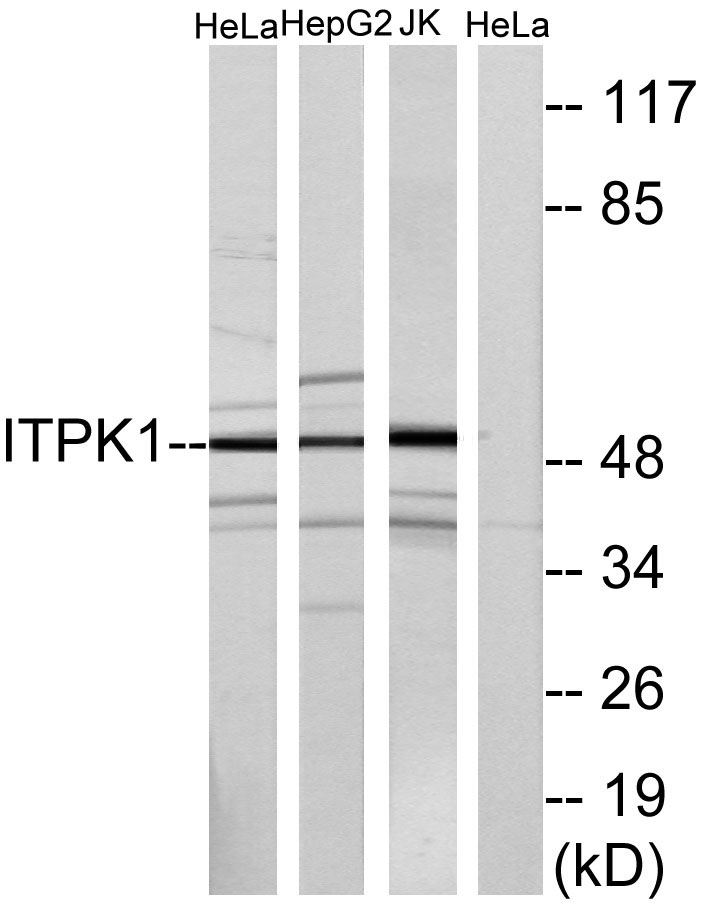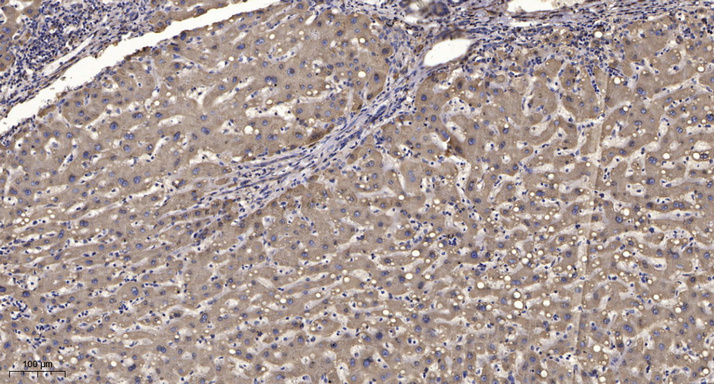ITPK1 Polyclonal Antibody
- Catalog No.:YT2416
- Applications:WB;ELISA;IHC
- Reactivity:Human;Mouse
- Target:
- ITPK1
- Fields:
- >>Inositol phosphate metabolism;>>Metabolic pathways;>>Phosphatidylinositol signaling system
- Gene Name:
- ITPK1
- Protein Name:
- Inositol-tetrakisphosphate 1-kinase
- Human Gene Id:
- 3705
- Human Swiss Prot No:
- Q13572
- Mouse Gene Id:
- 217837
- Mouse Swiss Prot No:
- Q8BYN3
- Immunogen:
- The antiserum was produced against synthesized peptide derived from human ITPK1. AA range:81-130
- Specificity:
- ITPK1 Polyclonal Antibody detects endogenous levels of ITPK1 protein.
- Formulation:
- Liquid in PBS containing 50% glycerol, 0.5% BSA and 0.02% sodium azide.
- Source:
- Polyclonal, Rabbit,IgG
- Dilution:
- WB 1:500-2000;IHC 1:50-300; ELISA 2000-20000
- Purification:
- The antibody was affinity-purified from rabbit antiserum by affinity-chromatography using epitope-specific immunogen.
- Concentration:
- 1 mg/ml
- Storage Stability:
- -15°C to -25°C/1 year(Do not lower than -25°C)
- Other Name:
- ITPK1;Inositol-tetrakisphosphate 1-kinase;Inositol 1;3,4-trisphosphate 5/6-kinase;Inositol-triphosphate 5/6-kinase;Ins(1,3,4)P(3) 5/6-kinase
- Observed Band(KD):
- 50kD
- Background:
- This gene encodes an enzyme that belongs to the inositol 1,3,4-trisphosphate 5/6-kinase family. This enzyme regulates the synthesis of inositol tetraphosphate, and downstream products, inositol pentakisphosphate and inositol hexakisphosphate. Inositol metabolism plays a role in the development of the neural tube. Disruptions in this gene are thought to be associated with neural tube defects. A pseudogene of this gene has been identified on chromosome X. [provided by RefSeq, Jul 2016],
- Function:
- catalytic activity:ATP + 1D-myo-inositol 1,3,4-trisphosphate = ADP + 1D-myo-inositol 1,3,4,5-tetrakisphosphate.,catalytic activity:ATP + 1D-myo-inositol 1,3,4-trisphosphate = ADP + 1D-myo-inositol 1,3,4,6-tetrakisphosphate.,catalytic activity:ATP + 1D-myo-inositol 3,4,5,6-tetrakisphosphate = ADP + 1D-myo-inositol 1,3,4,5,6-pentakisphosphate.,caution:PubMed:11533064 detected some protein kinase activity and ability to phosphorylate transcription factors c-jun/JUN and ATF2. However, PubMed:15762844 showed that it does not have protein kinase activity.,cofactor:Binds 2 magnesium ions per subunit.,function:Kinase that can phosphorylate various inositol polyphosphate such as Ins(3,4,5,6)P4 or Ins(1,3,4)P3. Phosphorylates Ins(3,4,5,6)P4 at position 1 to form Ins(1,3,4,5,6)P5. This reaction is thought to have regulatory importance, since Ins(3,4,5,6)P4 is an inhibitor of plasma membrane Ca(2+)-
- Subcellular Location:
- intracellular,cytosol,apical plasma membrane,
- Expression:
- Expressed in brain > heart > skeletal muscle = kidney = pancreas = liver = placenta > lung. In brain, it is expressed in cerebellum, cerebral cortex, medulla, spinal cord, occipital lobe, frontal lobe, temporal lobe and putamen.
- June 19-2018
- WESTERN IMMUNOBLOTTING PROTOCOL
- June 19-2018
- IMMUNOHISTOCHEMISTRY-PARAFFIN PROTOCOL
- June 19-2018
- IMMUNOFLUORESCENCE PROTOCOL
- September 08-2020
- FLOW-CYTOMEYRT-PROTOCOL
- May 20-2022
- Cell-Based ELISA│解您多样本WB检测之困扰
- July 13-2018
- CELL-BASED-ELISA-PROTOCOL-FOR-ACETYL-PROTEIN
- July 13-2018
- CELL-BASED-ELISA-PROTOCOL-FOR-PHOSPHO-PROTEIN
- July 13-2018
- Antibody-FAQs
- Products Images

- Western blot analysis of lysates from HeLa, HepG2, and Jurkat cells, using ITPK1 Antibody. The lane on the right is blocked with the synthesized peptide.

- Western blot analysis of the lysates from HepG2 cells using ITPK1 antibody.

- Immunohistochemical analysis of paraffin-embedded human liver cancer. 1, Antibody was diluted at 1:200(4° overnight). 2, Tris-EDTA,pH9.0 was used for antigen retrieval. 3,Secondary antibody was diluted at 1:200(room temperature, 45min).



